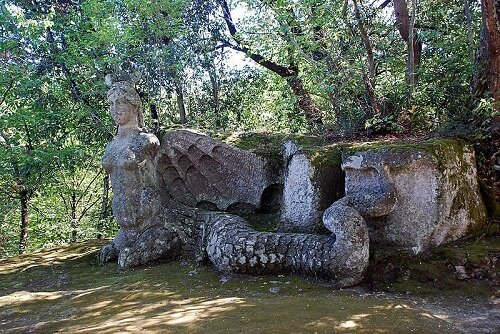10 Creatures From Greek and Norse Mythology
Going through my writing research, I thought I’d share a list of some of the many mythical creatures I’ve made notes of over the years.
In Greek mythology, the mother of many of their fearsome monsters was Echidna.
Echidna (Wikipedia)
Half-woman, half-snake, some accounts describe her as having the head of a beautiful woman and the body of a snake, while others depict her as hideous.
Together with her mate, Typhon, Echidna had a number of monstrous offspring. The ones commonly attributed to them are:
Orthros, the 2-headed dog, guardian of the red cattle of the giant, Geryon; slain by Hercules whose 10th labour was to take the giant’s cattle.
Cerberus, the dog with 3 ferocious heads and the tail of a snake, the guardian to the gates of Hades where only the dead may enter, and none may leave.
Only two heroes managed to triumph over Cerberus.
The legendary musician and poet, Orpheus, managed to lull Cerberus to sleep with his music when he entered Hades in search of his beloved wife, Eurydice.
Hercules was the other hero; his 12th labour was to kidnap Cerberus! Instead of tackling the task straightaway, Hercules made his way to Hades and asked the Lord of the Underworld if he could take his fearsome guardian. Hades agreed but only if Hercules could overpower Cerberus with nothing more than his own strength.
Hercules succeeded and eventually returned Cerberus to the gates of Hades.
Hercules and Cerberus ~ Peter Paul Rubens (Wikipedia)
Chimera, a fire-breathing lion with the head of a goat protruding from its back, and a snake’s head at the end of its tail.
Chimera, red figure dish at the Louvre Museum (Wikipedia)
The Nemean Lion, considered unstoppable because no human weapon could penetrate its hide. However, it fell before Hercules whose 1st labour was to slay the lion.
Hydra, the many-headed serpentine water monster with poisonous breath. Each time one of its heads was cut off, 2 new heads would grow. Interestingly, Hercules’ 2nd labour was to kill the hydra, which he did.
Hercule et l’Hydre de Lerne ~ Gustave Moreau (Wikipedia)
Sphinx, who possessed a woman’s head, the body of a lion and wings of a bird. Those who failed to answer her riddles would be killed and eaten.
Typhon, Echidna’s mate, was not only a monster but also a god, the son of Gaia and Tartarus. Some myths, though, place him as the child of Hera, who, in a fit of fury, wanted a god more powerful than her philandering husband.
Zeus aiming his lightning bolt at Typhon (Wikipedia)
In his ‘Theogony’, Hesiod describes Typhon as “terrible, outrageous and lawless.”
He was so tall, his head was said to touch the stars. Although his torso was that of a man, his head comprised hundreds of snake heads with each one uttering a different sound.
When Typhon challenged Zeus for Mount Olympus, the subsequent battle was long and arduous. In the end, firing many thunderbolts, Zeus prevailed. He flung Typhon into Tartarus and sealed him in by throwing Mount Etna over the opening.
Each time Typhon tries to struggle free, he causes earthquakes and volcanic eruptions.
From Greek to Norse mythology…
Fenrir, a wolf of immense proportions, is the eldest of the three children of Loki and the giantess, Angrboda.
Odin and Fenris by Mabel Dorothy Hardy, 1909 (Wikipedia)
When it was prophesied that the wolf and his family would, one day, be responsible for the destruction of the world, the gods caught him and locked him in a cage.
He was fed and cared for by Tyr, the god of war.
When he had grown, the gods knew they had to somehow make him harmless. They ordered the dwarves to make a magic chain strong enough to hold the wolf.
They fashioned Gleipnir from the footsteps of a cat, the roots of a mountain, a woman’s beard (!), the breath of fishes, the sinews of a bear, and bird’s spittle. It was as thin as a silk ribbon but stronger than any iron chain.
When presented with Gleipnir, Fenrir would only agree to being bound if one of the gods agreed to put his hand in the wolf’s mouth as a gesture of goodwill.
When none stepped forward, Tyr laughingly approached.
Realising he could not break Gleipnir, Fenrir bit Tyr’s hand off.
The gods chained the wolf to a rock in the earth and put a sword between his jaws to prevent him from biting.
On the day of Ragnarok, Fenrir will break his chains and join the giants in their battle against the gods. He will devour Odin, and Vidar, Odin’s son, will kill the wolf, avenging his father.
Jormundgandr, a sea serpent, is the middle child of Loki and Angrboda; the third being Hel.
Thor fighting the mighty worm Jormundgandr ~ Henry Fuseli (Wikipedia)
Fearing what the children of Loki and a giantess might do against the gods, Odin sent Hel to Niflheim and threw Jormundgandr into the ocean that surrounds the earth, Midgard.
The serpent grew to immense proportions and was able to surround the earth and grasp its own tail, earning it its other name, the Midgard Serpent.
When Jormundgandr releases its tail, Ragnarok will begin. In that battle, the serpent and his archenemy, Thor, will kill each other.






